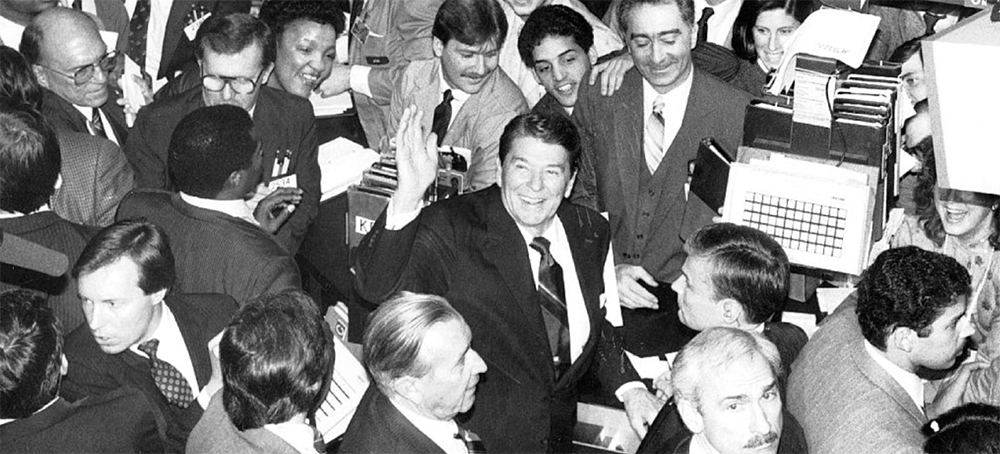For Proof Reaganomics Was a Sham, Look to American CEOs' Pay
Luke Savage Jacobin President Ronald Reagan stands on the floor of the New York Stock Exchange, 1985. (photo: Harry Hamburg/NY Daily News Archive/Getty Images)
President Ronald Reagan stands on the floor of the New York Stock Exchange, 1985. (photo: Harry Hamburg/NY Daily News Archive/Getty Images) For Proof Reaganomics Was a Sham, Look to American CEOs' Pay
Luke Savage Jacobin
CEO pay has jumped nearly 1,500 percent since 1978. It had nothing to do with hard work or greater productivity. Corporate bosses simply grabbed what they could.
It can be easy to forget, but the Reaganite economic project billed itself as a populist one. “Turning the bull loose” conjured the image of a powerful and dynamic beast ensnared by taxes and regulation which, once unmoored, would be free to unleash its energy at full speed. Though Reagan was speaking to financiers on that day in 1985, the supposed promise of his program was that gains at the top would be felt by everyone. With the necessary impediments removed, a common prosperity lay just over the next horizon.
Nearly forty years on, it’s sometimes said that trickle-down economics didn’t work — a statement that technically rings true if we go by its own official rhetoric. An alternative, and more accurate framing might be that it actually has worked as an effective means for the upward redistribution of wealth, which was more or less the whole point all along. Nowhere is that better illustrated than in the growth of CEO pay, the focus of a newly published study by Josh Bivens and Jori Kandra of the Economic Policy Institute.
Their top-line finding is a particularly eye-popping one: between 1978 and 2021, the pay of America’s CEOs has risen some 1,460 percent such that, by last year it was nearly four hundred times that of the average worker. That jump has vastly outstripped both the actual growth of the stock market and the earnings of the top 0.1 percent. The reason, or one of the reasons, is that existing structures of corporate governance mean that top CEOs, by virtue of their positions, are often able to extract fatter compensation packages from boards independent of performance or supposed market value. As Bivens and Kandra write:
The fact that CEO compensation has grown far faster than the pay of the top 0.1% of wage earners indicates that CEO compensation growth does not simply reflect a competitive race for skills (the “market for talent”) that also increases the value of highly paid professionals more generally. Rather, the growing pay differential between CEOs and top 0.1% earners suggests the growth of substantial economic rents (income not related to a corresponding growth of productivity) in CEO compensation. CEO compensation, it appears, does not reflect the greater productivity of executives but the specific power of CEOs to extract concessions.
CEO pay is therefore, in an important sense, not a wage as most people would understand it. Often coming in the form of stock options or stock awards, it partly consists of rents skimmed from any increase in productive output. It’s an irony, but by no means an accident, that the ultimate outcome of Reaganomics has been to establish a new class of robber barons whose wealth is in many ways unmoored from the very market discipline it claimed to be unleashing.
There’s an altogether separate debate to be had, of course, about the ethics of high “market-based” pay as well. The top 0.1 percent of earners may not have fared quite as well as America’s most lavishly compensated executives since 1978 but, adjusted for inflation, their annual earnings have still grown by 385 percent — an increase that hardly holds up under moral or ethical scrutiny either.
Still, the astonishing explosion in compensation for top CEOs is a reminder that Reaganomics hasn’t so much failed in its promise, but rather succeeded beyond the wildest dreams of those who cheered him from the trading floor of the New York Stock Exchange on March 28, 1985.
